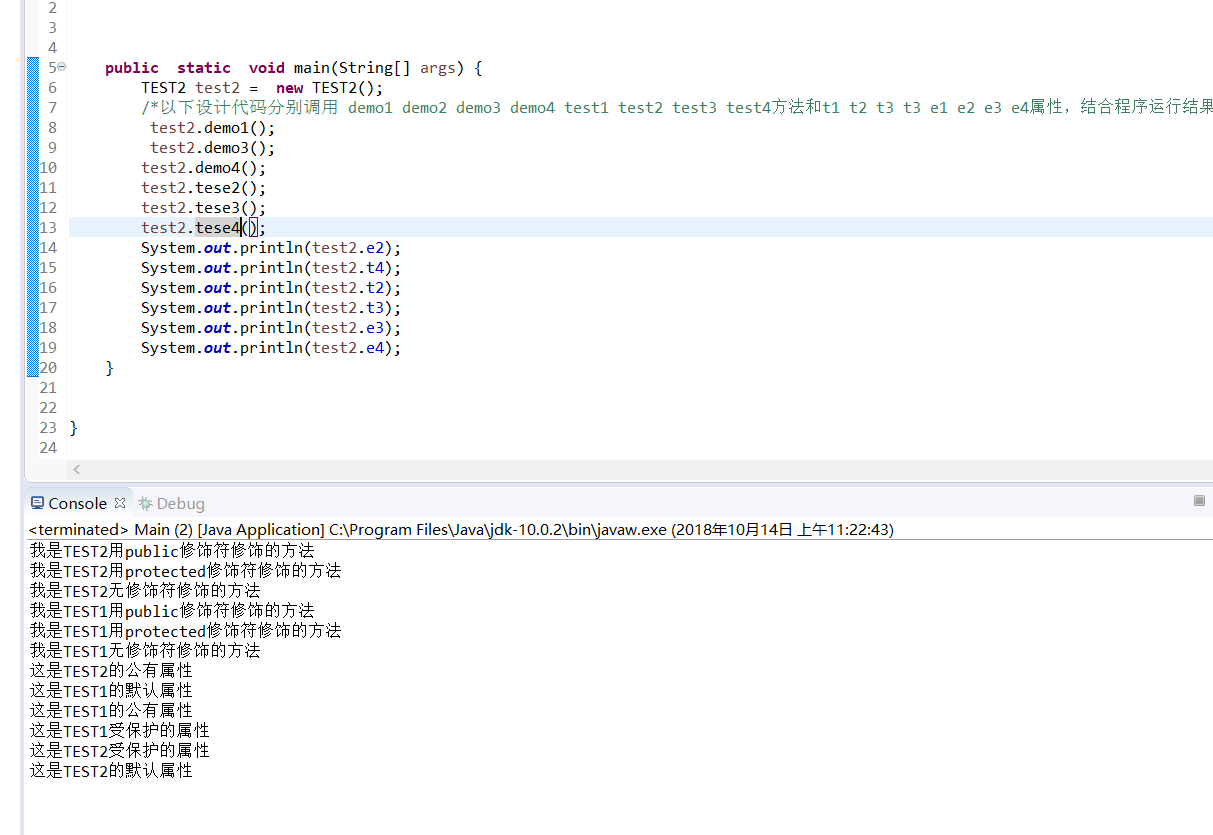实验七继承附加实验
实验时间 2018-10-11
类是否覆盖equals()方法”,将它分为2类。
(1) 若某个类没有覆盖equals()方法,当它的通过equals()比较两个对象时,实际上是比较两个对象是不是同一个对象。这时,等价于通过“==”去比较这两个对象。
(2) 我们可以覆盖类的equals()方法,来让equals()通过其它方式比较两个对象是否相等。通常的做法是:若两个对象的内容相等,则equals()方法返回true;否则,返回fasle。
1、实验目的与要求
(1)进一步理解4个成员访问权限修饰符的用途;
(2)掌握Object类的常用API用法;
1.Object类:
所有的类直接或间接继承Object,所有类都有Object方法.
toString():pubic String toString(); 默认方法:类的全路路径+@+十六进制的哈希地址值.
快捷键覆盖重写(alt+ins):表示对象的内容.@在我们直接使用输出语句的输出对象名的时候,其实是通过该对象调用了toSttring方法.
equals():public boolean equals(Object obj);默认方法:比较两个对象的地址值是否相同
.覆盖重写:比较两个对象内容是否相等.
自己重写equals:判断是否同一地址值,判断是否是空常量,判断是否同一类型,判断内容是否相等.
(3)掌握ArrayList类用法与常用API;
它和一般的数组不一样,不需要提前分配固定的空间(使用比较灵活),每次使用的时候可以添加进新的元素
1.比如你需要添加
String类型的数组:
ArrayList <String> s=new ArrayList<String>();//创建了s来保存String数组
s.add("hello");//向s中添加hello字符串
s.add("arraylist");
for(int i=0;i<s.size();i++)//s.size()是ArrayList的一个方法,返回结果是s的大小,就像数组的长度一样
System.out.print(s.get(i)+“ ”);//s.get(i)是获取s的第i个元素了
这样在终端就会打印出如下结果:hello arraylist
添加元素 boolean add(T obj) 吧元素的obj追加到数组列表的结尾
staff.add(new Employee(...));
统计个数 int size() 返回列表当前元
staff.add()
调整大小 void trimToSize() 把数组列表的存储空间调整到当前大小
访问 void set(int index,T obj) 将obj放入列表index位置,将覆盖这个位置的原有内容
T get(int index)获得指定位置index的元素值。
(4)掌握枚举类使用方法;
枚举:
.它不能有public的构造函数,这样做可以保证客户代码没有办法新建一个enum的实例。
.所有枚举值都是public , static , final的。注意这一点只是针对于枚举值,我们可以和在普通类里面定义 变量一样定义其它任何类型的非枚举变量,这些变量可以用任何你想用的修饰符。
.Enum默认实现了java.lang.Comparable接口。
.Enum覆载了了toString方法,因此我们如果调用Color.Blue.toString()默认返回字符串”Blue”.源码如下:
.Enum提供了一个valueOf方法,这个方法和toString方法是相对应的。调用valueOf(“Blue”)将返回Color.Blue.因此我们在自己重写toString方法的时候就要注意到这一点,一把来说应该相对应地重写valueOf方法。
.Enum还提供了values方法,这个方法使你能够方便的遍历所有的枚举值。
.Enum还有一个oridinal的方法,这个方法返回枚举值在枚举类种的顺序,这个顺序根据枚举值声明的顺序而定,这里Color.Red.ordinal()返回0。
(5)结合本章知识,理解继承与多态性两个面向对象程序设计特征,并体会其优点;
(6)熟练掌握Java语言中基于类、继承技术构造程序的语法知识(ch1-ch5);
(7)利用已掌握Java语言程序设计知识,学习设计开发含有1个主类、2个以上用户自定义类的应用程序。
2、实验内容和步骤
实验1 补充以下程序中主类内main方法体,以验证四种权限修饰符的用法。
|
public class TEST1 { private String t1 = "这是TEST1的私有属性"; public String t2 = "这是TEST1的公有属性"; protected String t3 = "这是TEST1受保护的属性"; String t4 = "这是TEST1的默认属性"; private void tese1() { System.out.println("我是TEST1用private修饰符修饰的方法"); } public void tese2() { System.out.println("我是TEST1用public修饰符修饰的方法"); } protected void tese3() { System.out.println("我是TEST1用protected修饰符修饰的方法"); } void tese4() { System.out.println("我是TEST1无修饰符修饰的方法"); } } public class TEST2 extends TEST1{ private String e1 = "这是TEST2的私有属性"; public String e2 = "这是TEST2的公有属性"; protected String e3 = "这是TEST2受保护的属性"; String e4 = "这是TEST2的默认属性"; public void demo1() { System.out.println("我是TEST2用public修饰符修饰的方法"); } private void demo2() { System.out.println("我是TEST2用private修饰符修饰的方法"); } protected void demo3() { System.out.println("我是TEST2用protected修饰符修饰的方法"); } void demo4() { System.out.println("我是TEST2无修饰符修饰的方法"); } } public class Main { public static void main(String[] args) { TEST2 test2 = new TEST2(); /*以下设计代码分别调用 demo1 demo2 demo3 demo4 test1 test2 test3 test4方法和t1 t2 t3 t3 e1 e2 e3 e4属性,结合程序运行结果理解继承和权限修饰符的用法与区别*/ } } |
补充代码如下:
public class Main { public static void main(String[] args) { TEST2 test2 = new TEST2(); /*以下设计代码分别调用 demo1 demo2 demo3 demo4 test1 test2 test3 test4方法和t1 t2 t3 t3 e1 e2 e3 e4属性,结合程序运行结果理解继承和权限修饰符的用法与区别*/ test2.demo1(); test2.demo3(); test2.demo4(); test2.tese2(); test2.tese3(); test2.tese4(); System.out.println(test2.e2); System.out.println(test2.t4); System.out.println(test2.t2); System.out.println(test2.t3); System.out.println(test2.e3); System.out.println(test2.e4); } }

实验2 第五章测试程序反思,继承知识总结。
测试程序1:
编辑、编译、调试运行教材程序5-8、5-9、5-10(教材174页-177页);
结合程序运行结果,理解程序代码,掌握Object类的定义及用法;
代码如下:

package equals; public class Manager extends Employee { private double bonus; public Manager(String name, double salary, int year, int month, int day) { super(name, salary, year, month, day); bonus = 0; } public double getSalary() { double baseSalary = super.getSalary(); return baseSalary + bonus; } public void setBonus(double bonus) { this.bonus = bonus; } public boolean equals(Object otherObject) { if (!super.equals(otherObject)) return false; Manager other = (Manager) otherObject; // super.equals 测验 this和otherObject是否属于同一类 return bonus == other.bonus; } public int hashCode() { return java.util.Objects.hash(super.hashCode(), bonus); } public String toString() { return super.toString() + "[bonus=" + bonus + "]"; } }

package equals; /** * This program demonstrates the equals method. * @version 1.12 2012-01-26 * @author Cay Horstmann */ public class EqualsTest { public static void main(String[] args) { Employee alice1 = new Employee("Alice Adams", 75000, 1987, 12, 15); Employee alice2 = alice1; Employee alice3 = new Employee("Alice Adams", 75000, 1987, 12, 15); Employee bob = new Employee("Bob Brandson", 50000, 1989, 10, 1); System.out.println("alice1 == alice2: " + (alice1 == alice2)); System.out.println("alice1 == alice3: " + (alice1 == alice3));//alice1和alice3属于两个不同的对象 System.out.println("alice1.equals(alice3): " + alice1.equals(alice3));//true 由于Empioyee对象的equals方法比较的是对象中的值,所以返回true。(和Object的equals方法不 System.out.println("alice1.equals(bob): " + alice1.equals(bob)); System.out.println("bob.toString(): " + bob);//调用employee类里面的toString Manager carl = new Manager("Carl Cracker", 80000, 1987, 12, 15); Manager boss = new Manager("Carl Cracker", 80000, 1987, 12, 15); boss.setBonus(5000); System.out.println("boss.toString(): " + boss); System.out.println("carl.equals(boss): " + carl.equals(boss)); System.out.println("alice1.hashCode(): " + alice1.hashCode()); System.out.println("alice3.hashCode(): " + alice3.hashCode()); System.out.println("bob.hashCode(): " + bob.hashCode()); System.out.println("carl.hashCode(): " + carl.hashCode()); } }
package equals; import java.time.*; import java.util.Objects; public class Employee {//超类的三个私有属性无法继承 private String name; private double salary; private LocalDate hireDay; public Employee(String name, double salary, int year, int month, int day) { this.name = name; this.salary = salary; hireDay = LocalDate.of(year, month, day); } public String getName() { return name; } public double getSalary() { return salary; } public LocalDate getHireDay() { return hireDay; } public void raiseSalary(double byPercent) { double raise = salary * byPercent / 100; salary += raise; } public boolean equals(Object otherObject) { // 检测this与otherObject是否引用同一个对象: if (this == otherObject) return true; //检测otherObject是否为null,如果为null,返回false。这项检测是很必要的 if (otherObject == null) return false; // 比较this和otherObject是否属于同一个类,如果equals的语义在每个子类中有所改变,就使用getClass()检测,它将自己作为目标类 if (getClass() != otherObject.getClass()) return false; // 将otherObject转换为相应类型的变量: Employee other = (Employee) otherObject; // 现在开始对所有需要比较的域进行比较。使用==比较基本类型域,使用equals比较对象域。如果所有域都匹配,就返回true,否则返回false; return Objects.equals(name, other.name) && salary == other.salary && Objects.equals(hireDay, other.hireDay); } //以上方法体为覆盖equals方法我们在Employee.java 中重写了Person的equals()函数:当两个Empioyee对象的 name 和 salary和hireday都相等,则返回true。 // 因此,运行结果返回true。 public int hashCode() { return Objects.hash(name, salary, hireDay); } public String toString() { return getClass().getName() + "[name=" + name + ",salary=" + salary + ",hireDay=" + hireDay + "]"; } }
测试程序2:
编辑、编译、调试运行教材程序5-11(教材182页);
结合程序运行结果,理解程序代码,掌握ArrayList类的定义及用法;
package arrayList; import java.util.*; /** * This program demonstrates the ArrayList class. * @version 1.11 2012-01-26 * @author Cay Horstmann */ public class ArrayListTest { public static void main(String[] args) { // 用三个 Employee objects填充动态数组 ArrayList<Employee> staff = new ArrayList<>();//动态数组的定义格式说明长度不确定 //利用ArrayList的API,add()把staff实例化 staff.add(new Employee("Carl Cracker", 75000, 1987, 12, 15)); staff.add(new Employee("Harry Hacker", 50000, 1989, 10, 1)); staff.add(new Employee("Tony Tester", 40000, 1990, 3, 15)); for (Employee e : staff) e.raiseSalary(5); //循环控制给每个人的工资上涨5% for (Employee e : staff) System.out.println("name=" + e.getName() + ",salary=" + e.getSalary() + ",hireDay=" + e.getHireDay()); } }

package arrayList; import java.time.*; public class Employee { private String name; private double salary; private LocalDate hireDay; public Employee(String name, double salary, int year, int month, int day) { this.name = name; this.salary = salary; hireDay = LocalDate.of(year, month, day); } public String getName() { return name; } public double getSalary() { return salary; } public LocalDate getHireDay() { return hireDay; } public void raiseSalary(double byPercent) { double raise = salary * byPercent / 100; salary += raise; } }
测试程序3:
编辑、编译、调试运行程序5-12(教材189页);
结合运行结果,理解程序代码,掌握枚举类的定义及用法;

package enums; import java.util.*; /** * This program demonstrates enumerated types. * @version 1.0 2004-05-24 * @author Cay Horstmann */ public class EnumTest { public static void main(String[] args) { Scanner in = new Scanner(System.in); System.out.print("Enter a size: (SMALL, MEDIUM, LARGE, EXTRA_LARGE) "); String input = in.next().toUpperCase(); Size size = Enum.valueOf(Size.class, input);//生成枚举类对象 System.out.println("size=" + size); System.out.println("abbreviation=" + size.getAbbreviation()); if (size == Size.EXTRA_LARGE) System.out.println("Good job--you paid attention to the _."); } } enum Size//定义了枚举类 { SMALL("S"), MEDIUM("M"), LARGE("L"), EXTRA_LARGE("XL");//规定的不同枚举值 private Size(String abbreviation) { this.abbreviation = abbreviation; } public String getAbbreviation() { return abbreviation; } private String abbreviation; }

实验3:采用个人账号登录https://pintia.cn/,完成《2018秋季西北师范大学面向对象程序设计(Java)(ch1-ch5)测试题2》,测试时间60分钟;
实验4: 课后完成实验3未完成的测试内容。
